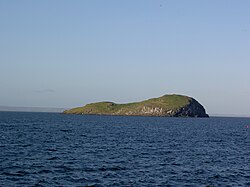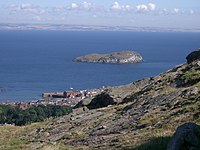Craigleith
| Craigleith | |
 Craigleith from North Berwick | |
|---|---|
| Location | |
| Grid reference: | NT552870 |
| Highest point: | 79 feet |
| Data | |
Craigleith is a small island in the Firth of Forth off North Berwick in East Lothian. Its name means "Rock of Leith", which may be from Gaelic, Old Welsh or from the word, Craig, inported into Scots from either. It is 79 feet above the waves at its highest point.
Geography and geology
Craigleith makes up the chain of islands near North Berwick along with Bass Rock, Fidra and The Lamb. Of the four islands it is the closest to the town's harbour. Like the other nearby islands, Craigleith is a bird colony. Divers often explore the area around the island.
Craigleith is a laccolith, a lava dome. The Lothians are dotted with evidence of ancient volcanic activity, such as the Bass Rock and Arthur's Seat. It is made up of essexite which is popular for making curling stones.[1]
History and wildlife
Historically, Craigleith was a rabbit warren, where the animals were deliberately bred for food. Rabbits were wiped out by myxomatosis in the 1950s. They were mysteriously re-introduced onto the island in 2008, and some have been seen recently.
In 1814, Sir Hew Dalrymple purchased the island from North Berwick Town Council.[1]
The puffin colony on Craigleith, once one of the largest in Britain with 28,000 pairs became endangered from 1999 onwards, due to an invasion of the non-endemic plant tree mallow, thriving with warmer winters, which choked the puffins' burrows, preventing from rearing their chicks, or "pufflings". A five year project, SOS Puffin, led by the Scottish Seabird Centre at North Berwick, was launched early in 2007 after one of the Centre's volunteers, Maggie Sheddan noticed the ever decreasing numbers of puffins. Since then, hundreds of volunteers have been working hard to rid the island of the problem, ferried out by boat from the Seabird Centre during the winter months, when the puffins are out at sea. Initial results show that there are signs that the puffins are starting to return to the island to breed. [2] Cormorants, shags and guillemots breed here.
The Scottish Seabird Centre has solar powered cameras on the islands which transmit images of the puffins and other wildlife on the island by live webcams. Daily boat trips will be sailing around the island as from 2008.
Outside links
- Report of overnight stay on the island
- Seabird – for Webcams of Craigleith
References
- ↑ 1.0 1.1 "Overview of Craigleith". Gazetteer for Scotland. http://www.scottish-places.info/features/featurefirst1600.html. Retrieved 2008-02-08.
- ↑ Ian Johnston (2 March 2007). "£235,000 lifeline for puffins driven out by ruthless march of the mallow". The Scotsman. http://news.scotsman.com/latestnews/235000-lifeline-for-puffins-driven.3350796.jp. Retrieved 2008-02-08.
- Haswell-Smith, Hamish (2004). The Scottish Islands. Edinburgh: Canongate. ISBN 1841954543.
| The islands of the Firth of Forth | |||
|---|---|---|---|
| West Lothian | Midlothian | East Lothian | Fife |
| Inchgarvie | Cramond Island • Inchmickery • Cow and Calves | Bass Rock • Craigleith • Eyebroughy • Fidra • The Lamb | Inchcolm • Oxcars • Isle of May • Inchkeith |
